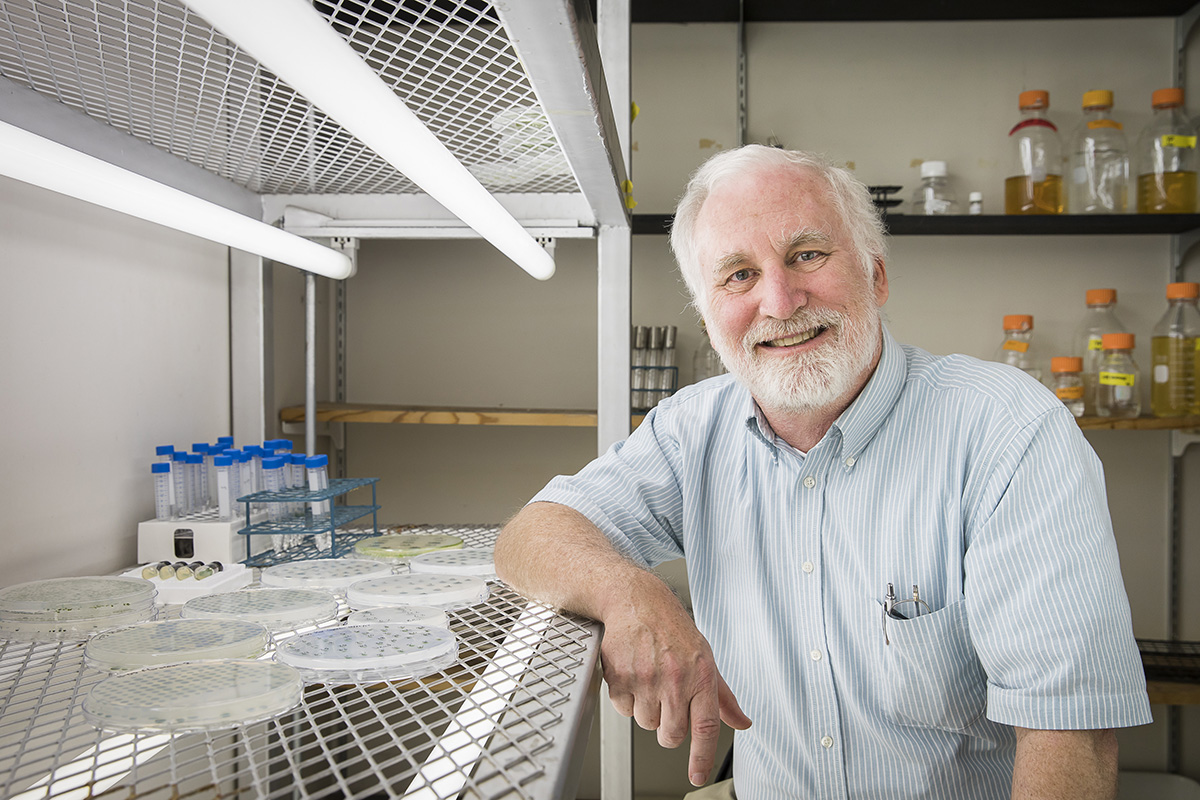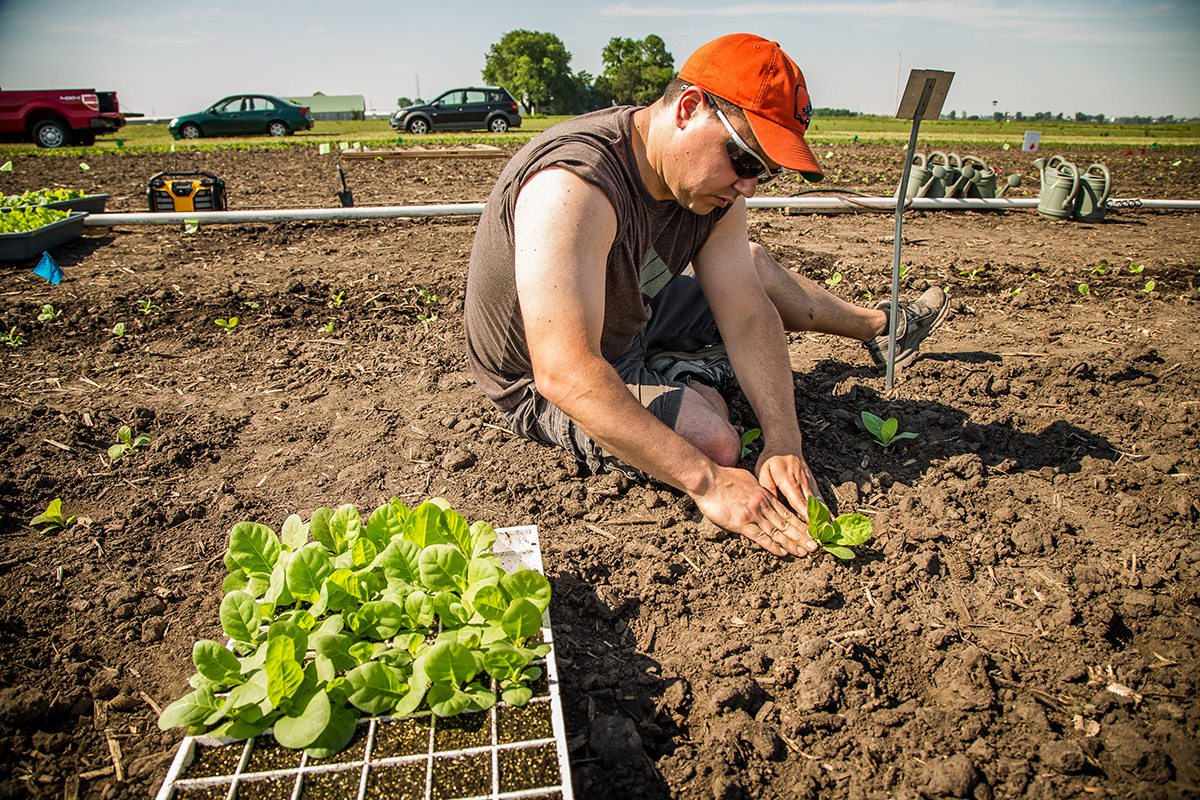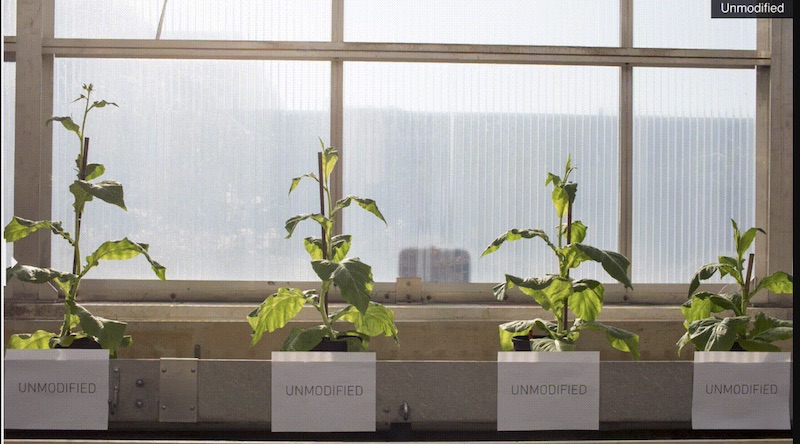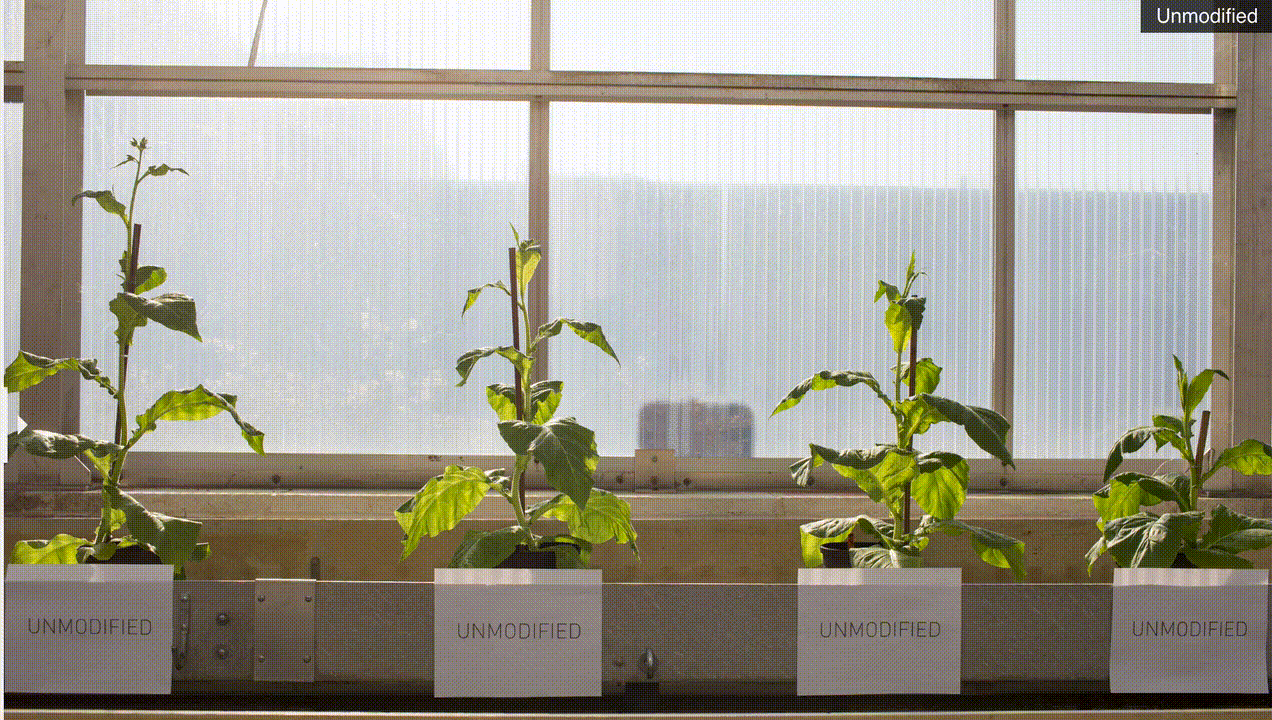Feeding Our Future Planet
LSU biologists are unlocking photosynthetic technologies in algae and plants to “teach” important crops such as rice, wheat, and soybeans to grow bigger, faster.

James Moroney in his lab.
LSU
When he’s not teaching freshman biology to 250 students, LSU scientist James Moroney
continues a 35-year mission to save the world in other ways. He and his colleague
Paul South study photosynthesis—the main driver of life on our planet. Through photosynthesis,
plants make food for most life forms, as well as oxygen and fuel. All they need is
sunlight and water, and plants can take carbon dioxide from the air and introduce
it to an enzyme called rubisco—the most abundant protein in the world—to create organic
matter. This means food for everyone, either directly (you eat the plant) or indirectly
(you eat the animal that ate the plant, or the animal that ate the animal that ate
the plant, and so on).
The problem with photosynthesis that Moroney and South are trying to solve is that
it can be a glitchy process. Rubisco is an ancient enzyme that is, well, getting somewhat
confused. Instead of grabbing a carbon dioxide molecule from the air, it occasionally
takes an oxygen instead—every four or five times. This might not sound like a big
deal, but instead of making organic matter (that is, food), the plant then makes something
called glycolate, which pollutes the plant and needs to be cleaned up. To do so, plants
evolved something called photorespiration, a kind of “oops machine” or recycling station.
But it’s a complicated and exhausting process. Instead of having their recycling bin
in their kitchen, so to speak, plants put the bin in their garage, on the other side
of the laundry room, beyond the den.
After the so-called green revolution saved over a billion people from starvation between 1960 and 2005 thanks to research and technological advances in high-yielding varieties, irrigation, crop management, fertilizers, and pesticides, etc., mankind will likely need another revolution to boost yield in years to come.
To solve this problem, South engineered a recycling shortcut so plants don’t waste
energy along with some of the carbon dioxide they’ve already processed and instead
can continue to photosynthesize and grow. When he walked into the greenhouse in 2016
and saw for the first time that the plants he’d engineered were much bigger than the
others, he knew he was on to something.
“I didn’t have to measure—I could see right away,” South said. “We had almost a 40-percent
increase in plant growth. After that, it got really exciting. People were shocked
at the amount of increase we observed.”
The goal of South’s and Moroney’s work of making photosynthesis more efficient is
to help feed the planet in the future. The earth’s population is expected to reach
almost 10 billion in 2050 and without innovation, many will go hungry. Meanwhile,
because of our changing climate and because people also need somewhere to live, we’ll
likely have less and less room for traditional agriculture. While Moroney so far has
mostly worked on algae and South on tobacco plants, their idea is not to feed people
algae pudding or dampen hunger with cigarettes. What they’re doing is learning about
specific plant technologies from test plants that know a few tricks and also are easy
to manage. Once they fully understand these technologies, they plan on transferring
them into some of the biggest crops, such as rice, corn, soybeans, and cassava (used
to make tapioca). South is about to start experimenting with black-eyed peas, which
are commonly grown in sub-Saharan Africa. He hopes to start them in the lab soon,
do greenhouse experiments next year, and then move on to field trials in 2022.

Paul South transfers test tobacco plants to the field.
Photo courtesy of the RIPE Project/University of Illinois
“The next question is how much of an increase we’ll see when we put this into crops,”
South said. “But even if we only get a 10-percent increase in growth, this would still
be a huge benefit and a lot more food.”
A big part of South’s work is educating people about genetically modified organisms,
or GMOs. Many foods sold in grocery stores are advertised as being “non-GMO,” so the
assumption is that GMOs are bad and something to avoid altogether. But that’s not
true, South said. Everything he does as a researcher is to come up with better GMOs.
After the so-called green revolution saved over a billion people from starvation between
1960 and 2005 thanks to research and technological advances in high-yielding varieties,
irrigation, crop management, fertilizers, and pesticides, etc., mankind will likely
need another revolution to boost yield in years to come.
“Climate change is happening faster than evolution can possibly keep up. We don’t have time to wait for plants to naturally evolve, so we’re going to need these tools to develop plants so we can have a nutritious and affordable food supply.”—Paul South
“I used to talk in great detail about the safety of GMOs and how what we’re doing
in plants is very precise, but that’s hard to explain to non-scientists,” South said.
“I’d get glazed looks on people’s faces, and that’s when I decided to take my scientist
hat off and put my dad hat on.”
Wearing his “dad hat,” South focuses on how he wants safe, nutritious, and affordable
food for his family, and how he sees GMOs as part of that equation. He’s the first
to admit that most GMOs on the market today don’t necessarily benefit the consumer.
“Many GMOs on the market today are farmer-focused to help them address pests or weeds
that threaten their yields,” South said. “But on the flip side, genetic modification
is a technology we can apply to make crops more consumer-friendly by adding more nutrients,
like vitamin A, or by increasing productivity to shrink families’ grocery bills one
day.”
South is also quick to bring the potential benefit of his research on GMO crops into
the context of climate change.
“Climate change is happening faster than evolution can possibly keep up,” he said.
“We don’t have time to wait for plants to naturally evolve, so we’re going to need
these tools to develop plants so we can have a nutritious and affordable food supply.
The science is safe, and the potential for usefulness is really high. That’s why I
tell people I love GMOs. It’s a newer technology that has the potential to benefit
us in ways we don’t even understand yet.”
Part of South’s reason for joining LSU and working alongside Moroney is because he
wants to study photorespiration in warmer climates where it occurs more frequently.
The rubisco enzyme becomes even more confused at high temperatures, producing more
glycolate and increasing the need for the “oops machine” to kick in. It is estimated
that in crops like soybeans—especially here in Louisiana—summer temperatures can reduce
photosynthetic efficiency by up to 50 percent because of photorespiration. This is
also due to plants closing their leaves to save water when it’s really hot out. When
they do that, they limit the amount of carbon dioxide they can access from the air.
In all fairness, rubisco evolved millions of years ago when the atmosphere was full
of carbon dioxide and little to no oxygen. But since photosynthesis creates oxygen,
rubisco has in many ways become a victim of its own success.



Modified versus unmodified plants; as Paul South re-engineered the plant technology,
he noticed a remarkable increase in growth—up to 40 percent.
Animation courtesy of the RIPE Project/University of Illinois
“The importance of this work is becoming more obvious, I think. Mainly, it would be nice if we all can make it to 2100 without another World War. People get unhappy when they’re not fed.”—James Moroney
One of the reasons Moroney is so interested in algae is because algae have evolved
to be quite good at photosynthesis in an environment (water) despite lower concentrations
of carbon dioxide. So good, in fact, that half of the world’s photosynthesis is done
by algae; they are a major component of the biosphere. But exactly how algae take
carbon dioxide out of the environment and do so much more effectively than terrestrial
plants became a complicated cell biology question.
“I would have told you, when I started working on this 35 years ago, that in five
years, I’d be done with this research,” Moroney said. “Yet, here I am. I’ve worked
on the same project for 35 years. What started out as science fiction is still close
to science fiction in that the potential payoff remains far off in the future, but
Paul [South] is closer to saving the world than I am. He’s actually putting plants
in the ground. You know, I considered retiring a few years back, but now I’m so glad
I didn’t. We have a great team.”
Algae use what’s called a carbon dioxide-concentrating mechanism to make the molecules
more accessible for the rubisco. While rubisco performs less well in warm waters,
as on land, and the solubility of carbon dioxide in water goes down as temperatures
rise—meaning, algae photosynthesis also suffers from global warming—terrestrial plants
could still benefit from “algae technology.”
“The simplest explanation of what we do is we put proteins and genes from algae into
plants on land to see if they’ll pull in carbon dioxide better,” Moroney said.
Back in 2011, Moroney was one of only a few scientists in the world who were studying
photosynthesis from an efficiency perspective. He was invited, along with a dozen
others from around the world, to the Bill & Melinda Gates Foundation to talk about
their work and the possibilities they saw for future research. That meeting began
Moroney’s (and later, South’s) involvement in the RIPE (Realizing Increased Photosynthetic
Efficiency) project, funded with $25 million from the Bill & Melinda Gates Foundation
and $20 million from the Foundation for Food and Agriculture Research and the U.K.
Government’s Foreign, Commonwealth & Development Office. RIPE is one of the biggest
plant science projects in the world.
“We fund the work of the RIPE team, including Dr. Moroney and Dr. South, because of
the long-term potential of this research to transform the lives of millions of smallholder
farmers who depend on agriculture to feed their families and earn an income,” Kathy
Kahn, senior program officer at the Bill & Melinda Gates Foundation, said on the motivations
behind their involvement.
Moroney and South work closely with researchers in Australia, England, and China and
at two other universities in the U.S.—Illinois and Berkeley.
“The importance of this work is becoming more obvious, I think,” Moroney said. “Mainly,
it would be nice if we all can make it to 2100 without another World War. People get
unhappy when they’re not fed.”
South, of course, agrees.
“Photosynthesis is the most important biochemical pathway on the planet,” South said.
“Every carbon molecule in your body probably passed through photosynthesis at some
point. It’s the primary source through which we can use energy from the sun to make
food for everything else. Talking about food security or insecurity, I’ve heard the
comment—why not study cancer or heart disease or something like that to help save
lives instead? My off-the-cuff reply tends to be that if we don’t have photosynthesis,
we don’t have food, and without food we won’t live long enough to get cancer or heart
disease, so we should probably start with the basics.”
Learning From Algae
James Moroney found a missing link in algal photosynthesis, offering a new opportunity
to improve crop yields. Algae are much better at photosynthesis than plants, so crops
have a lot to “learn” from them.
Feeding the World
Paul South engineered a shortcut in plants to make photosynthesis more efficient.
He is now working on transferring the technology to crops to make them grow bigger,
faster.
Paul South is an assistant professor of plant physiology in the Department of Biological Sciences
with a joint position at the LSU AgCenter.
James Moroney is the Glenda Wooters Streva Alumni Professor in the Department of Biological Sciences.
Elsa Hahne
LSU Office of Research & Economic Development
[email protected]